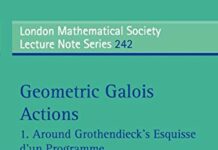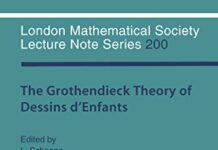
Ebook Info
- Published: 2013
- Number of pages: 274 pages
- Format: PDF
- File Size: 3.54 MB
- Authors: Leila Schneps
Description
In the wrong hands, math can be deadly. Even the simplest numbers can become powerful forces when manipulated by politicians or the media, but in the case of the law, your liberty — and your life — can depend on the right calculation. In Math on Trial, mathematicians Leila Schneps and Coralie Colmez describe ten trials spanning from the nineteenth century to today, in which mathematical arguments were used — and disastrously misused — as evidence. They tell the stories of Sally Clark, who was accused of murdering her children by a doctor with a faulty sense of calculation; of nineteenth-century tycoon Hetty Green, whose dispute over her aunt’s will became a signal case in the forensic use of mathematics; and of the case of Amanda Knox, in which a judge’s misunderstanding of probability led him to discount critical evidence — which might have kept her in jail. Offering a fresh angle on cases from the nineteenth-century Dreyfus affair to the murder trial of Dutch nurse Lucia de Berk, Schneps and Colmez show how the improper application of mathematical concepts can mean the difference between walking free and life in prison. A colorful narrative of mathematical abuse, Math on Trial blends courtroom drama, history, and math to show that legal expertise isn’t’t always enough to prove a person innocent.
User’s Reviews
Reviews from Amazon users which were colected at the time this book was published on the website:
⭐The authors discuss a number of notable court cases in which defendants were initially convicted on the basis of bad math, specifically on the basis of misunderstandings about how to figure the odds of certain series or circumstances taking place. A few slightly difficult applications of Bayes theorems are introduced. But for the most part, the explanations about how statistics should be interpreted are accessible – and could be useful in our everyday lives.The court cases discussed are as follows:The Sally Clark Case – the case of a mother who had two children die of SIDS and who was convicted based on a miscalculation of the likelihood of that happening naturally.The Janet Collins Case – the case of an interracial couple who were committing street robberies. Collins’ conviction was based on the fact that a number of identifying factors, such as the woman’s hair style and the color of the car used by the couple, were considered separately. Later, more sophisticated statistical calculations took into account the fact that some of these factors might be expected to appear together. This is the only case that left me feeling a little doubtful about the exonerating revision of the statistics applied.The Case of Joe Sneed, convicted of killing his parents. Here, some of the statistical considerations revolve around what the book’s authors consider to be false leads followed by the police. For example, the police spent a lot of time calculating how common the name “Robert Crossett” was in real life. That’s the name that Sneed seemingly used as an alias as he was traveling across-country to his parents’ home. It’s argued that the frequency with which that name might appear in phone books was irrelevant – since the name was likely made-up.The Amanda Knox Case – in which Amanda was initially convicted of participating in the killing of her roommate in Perugia, Italy. Here the book’s authors take the somewhat minority view that Amanda is guilty. They cite as evidence trace amounts of DNA discovered on a knife in the apartment of Amanda’s boyfriend. Reading this chapter, I found it helpful to recall what I’d recently read in another book, “Inside the Cell: The Dark Side of Forensic DNA” by Erin Murphy.” In that book, Murphy tells how difficult and error-prone it can be to try to analyze minute traces of DNA. I strongly suggest that readers consider the arguments in both books, “The Dark Side” and “Math on Trial.”The Diana Sylvester Case – in which a woman was found murdered in 1972. Decades later, it became possible to analyze trace amounts of DNA left at the scene and to bring a suspect to trial. The problem was approached as a variant of “The Birthday Problem” – the likelihood that two people in a party of 23 would have the same birthday. Two expert witnesses testified, each offering a different set of odds regarding the likelihood of a DNA match when only a limited amount of DNA is available. The same principles involved in this problem are also involved in some of the other cases discussed in this book. They are problems that everyone is likely to face frequently in life and so should be of special interest to readers.The Berkeley Sex Bias Case – which involved the question of whether women were being discriminated against when it came to promotions within the Berkeley math department. This involved proper ways of calculating the “p-value” of a situation, that is, the probability that some seeming imbalance or disproportion can occur naturally rather than as the result of intention.The Case of Charles Ponzi – which involves awareness of how schemes involving exponential growth can spiral out of control. There is a lot of interesting history in this chapter. Readers get to meet the original Ponzi, a lovably roguish “character” from the early part of the 20th century.The Case of Hetty Green – the richest woman in America during the country’s “Gilded Age.” This chapter introduces us to another fascinating “character.” The math question posed involves handwriting analysis as it pertained to a will Hetty was suspected of forging. How often can two people be expected to form their written letters in the same way? Readers might feel inspired to apply some of the principles discussed here to their own attempts to analyze the JonBenet Ramsey ransom note.The Dreyfus Case – involving a charge of treason brought against a Captain in the French Army in the late 1800s. Again, much of the case revolved around the statistical analysis of handwriting samples.Because of the quantity of misleading testimony given by “experts” in statistics and math in the above cases – certain Supreme Court rulings prohibited statistical analysis from being dispositive in criminal cases, for the same reasons that the outcome of lie detector tests can’t be introduced as “proof.” However, with the advent of DNA, that ban on statistics has been modified.Still, the question remains – what does it really mean, or what should it mean, when they say the results of a DNA test show that a defendant has a 1 in 10 billion chance of being not guilty? Readers will get an easy course in some basic statistics from this book, as well as some entertaining history lessons involving colorful characters.
⭐This book deals with an important topic, the use of mathematics in the legal process. It provides some very interesting examples of the use and abuse of math in a variety of cases. Unfortunately, in the two cases with which I have to most familiarity the analysis seems flawed and there is in too much focus on irrelevant anecdotes and not enough on analytical issues. The chapter on Ponzi schemes spends a great deal of space on the details of Charles Ponzi’s life. It then develops a mathematical model demonstrating why it would be impossible for a Ponzi scheme to last more than 2 or 3 years because of the exponential growth in the demands for the perpetrators to send out interest payments to investors. The mathematical model makes some implicit assumptions about investor behavior concerning which it may have been useful to consult with someone knowledgeable about finance. This almost immediately gets the authors into trouble when the chapter then briefly discusses the Madoff scheme which lasted some 16 years without discussing why or how the “mathematical model” did not apply. The answer is that Madoff offered a lower return and that many investors allowed their interest payments to stay invested with Madoff. An investor giving the book a superficial read might conclude that any investment vehicle that had been in existence for more than 3 years could not possibly be a Ponzi and therefore must be legitimate – I don’t think a hapless investor of this type could sue the authors of this book, but he might be a bit less than enthusiastic about their financial analysis.The second case is the notorious and controversial Amanda Knox case. Unfortunately, this case has produced two sharply divided camps – one of which asserts that the defendants are clearly guilty, the other of which is just as sure of innocence. Oddly enough, it appears to have produced virtually no observers who profess any doubt at all about the matter. This itself (especially in the context of a reasonable doubt standard) might have been an interesting topic for the authors to dissect. The writers appear to have pitched their tents in the first camp which asserts guilt and unfortunately state certain disputed issues (whether the forensic evidence established that there was more than one perpetrator) as settled when in fact they are hotly contended and misstate a key fact (although the authors correctly state that the knife which is pivotal in the case tested negative for blood, they confusingly go on to state that the police found a speck of blood on the knife; in fact, there is no evidence of any blood on the knife). As with finance in the Ponzi example, the authors attempt to become DNA experts by describing the process in some detail and explaining why they believe the police laboratory results were reliable. In fact, numerous independent DNA experts have concluded otherwise. More importantly, the authors neglect the key question of why the lab has adamantly refused to provide electronic data files which are essential to an evaluation of its work. The authors’ conclusion that a new test would reduce uncertainty should have been conditioned in several respects – a new test would not reduce uncertainty associated with pre-test contamination nor would it increase certainty unless the probability of error in the second test is independent of whether there was an error in the first test.Elsewhere in the book, the authors discuss Bayes’ Theorem and provide an excellent explanation of just how it applies in a challenging case.It would have been helpful for the authors to describe just when and how Bayes’ Theorem should be applied in other cases and how mathematical issues can be addressed when Bayes’ Theorem is inapplicable.The authors are talented writers and generally explain math in terms which are accessible to laymen. On occasion, they fail to state their assumptions and this can produce confusion.I hope they do another, better, book which analyzes in more depth what we can do to prevent both wrongful acquittals and wrongful convictions.
⭐For those who may be wondering, mathematical expertise is not needed to enjoy this delightful book. That is a good thing because the authors deliver an important message to anyone who has an interest in justice: math has played and will continue to play an increasingly decisive role in the courtroom. As this book clearly demonstrates, getting it wrong can convict the innocent or exonerate the guilty.Given the book’s weighty topic some might be surprised to hear it described as entertaining. I’m happy to report that the authors did a wonderful job selecting case studies that are fascinating with or without the role played by mathematics. Each of the ten cases has one or more elements of surprise, heartbreak, mystery, frustration, irony and even humor (depending on your proclivities). They are never dull. It’s clear that the authors did extensive research and chose these cases with care.Each chapter begins with a brief introduction to a specific kind of math “error”. The error is described in simple language and illustrated with an easy to grasp real life example like the common occurrence of a shared birthday. The authors then show how the mathematical concept at hand was misused in the case under discussion.One thing that I found particularly delightful (and disturbing) was how often these math concepts were counter-intuitive. It’s easy to see how lawyers, judges, and prosecutors got things wrong. This simple fact makes a strong case that true expertise is needed to assist these critical players. And that is why this book is essential. If you are involved in the criminal justice system, please read this book.
⭐How maths is used and abused at courtroom trials. Very informative.
⭐Very insightful book, but possibly a little biased in its overall content. Nevertheless, a very salutary lesson for those who might think they can apply statistics without a very thorough understanding of the subject.
⭐Great book. Definitely worth a read.
⭐Very interesting read. Keeps the brain active all the way through.
⭐I loved this book! It was interesting to learn how maths can play an important part in our courts, provided it is used correctly. This book includes several real-life examples of when it hasn’t been applied correctly, and for some people it has resulted in them being found guilty for appalling crimes when in fact they were completely innocent. Don’t be put off if you are a non-mathematician (like me!), it’s written in plain English and flows incredibly well.Definitely one I’d recommend!!
Keywords
Free Download Math on Trial: How Numbers Get Used and Abused in the Courtroom in PDF format
Math on Trial: How Numbers Get Used and Abused in the Courtroom PDF Free Download
Download Math on Trial: How Numbers Get Used and Abused in the Courtroom 2013 PDF Free
Math on Trial: How Numbers Get Used and Abused in the Courtroom 2013 PDF Free Download
Download Math on Trial: How Numbers Get Used and Abused in the Courtroom PDF
Free Download Ebook Math on Trial: How Numbers Get Used and Abused in the Courtroom


